I just returned to the lake after being away for two weeks and found a number of faithful signs of spring waiting for me. Several of those plants and progress on a new garden bed are my subjects for this Saturday. Readers can follow the developments in other gardens around the globe by visiting the site of the Propagator and following the wealth of links there.
1. One of these signs of spring that pleases me the most is the leafing out and budding of my red buckeye (Aesculus pavia). I think this is such a favorite because I grew it from a buckeye fruit and have watched its maturation patiently. I also like watching the dramatic opening of its palmate leaves. That is why I chose the featured photo I did. The photos below show the branching and leafing structure as well as the burgeoning buds. They also show that Rosie likes to watch for signs of spring as well.
2. For many in Alabama, the bluets are one of the most welcomed harbingers of spring. Houstonia is a delicate plant genus with a variety of species, and I confess, I cannot identify those below specifically. Nonetheless, they are generous in their appearances throughout the open areas of the garden, in leaves, and in moss and grass. 3. The next herald for today, wake robin, or Trillium erectum, is abundant this year–even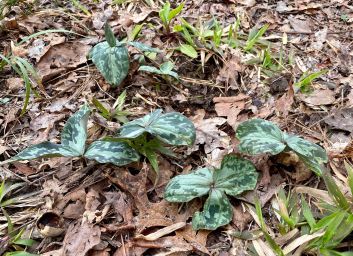 in areas that are prone to pet traffic. Of course, most of the plants are coming up in the wooded area of the garden. As yet they are small and few are beginning to open up to their red centers. According to that oracle of world-wide general knowledge, Wikipedia, “The plant takes its common name ‘wake robin’ by analogy with the European robin, which has a red breast heralding spring.”
4. Being away I missed the brightest blooming of forsythia, yet some blossoms remain. This, the largest of the bushes, is the only one that has put on leaves, though.
in areas that are prone to pet traffic. Of course, most of the plants are coming up in the wooded area of the garden. As yet they are small and few are beginning to open up to their red centers. According to that oracle of world-wide general knowledge, Wikipedia, “The plant takes its common name ‘wake robin’ by analogy with the European robin, which has a red breast heralding spring.”
4. Being away I missed the brightest blooming of forsythia, yet some blossoms remain. This, the largest of the bushes, is the only one that has put on leaves, though.
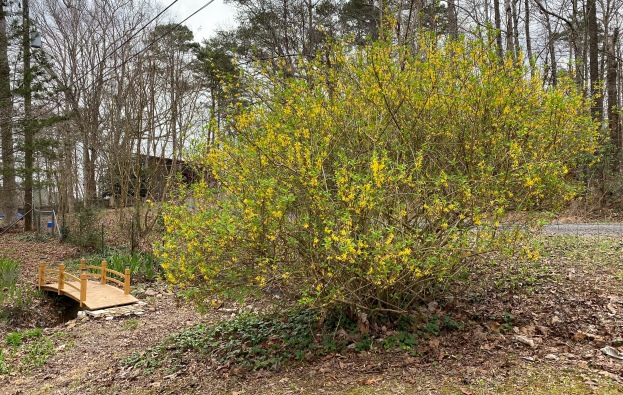
Actually, the other forsythias I have, and there are at least four more, are rather scraggly. The cause could be the lack of sun they receive compared to the one above. Stress from previous drought periods might also contribute to their sparse appearance. Apparently, the wet, mild winter has not inhibited the insect population, though.
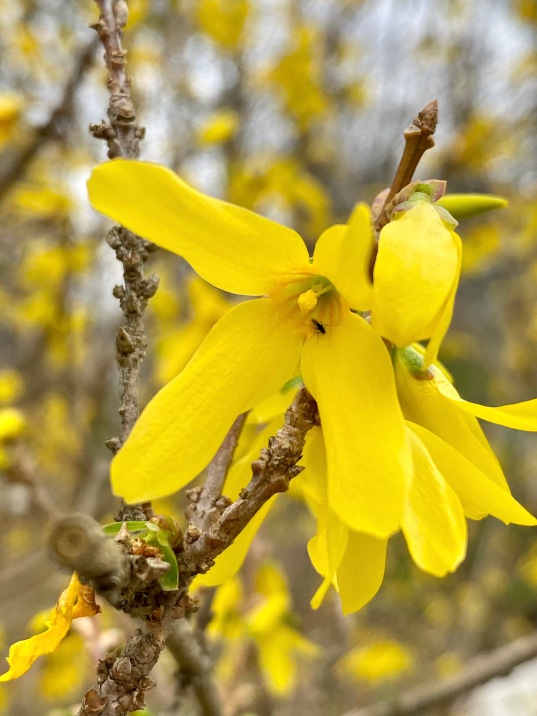
5. There are a couple of developments of new plantings worth sharing as well. The first of those is the growth of a flowering quince (Chaenomeles speciosa), that I think of I have mentioned before, reminds me of summers in Oxford, England. It will require some judicious pruning for shape in time, but for now I am just pleased with its growth. The trillium in the upper right corner of the photo is worth noticing. As I said above, it is abundant this year.
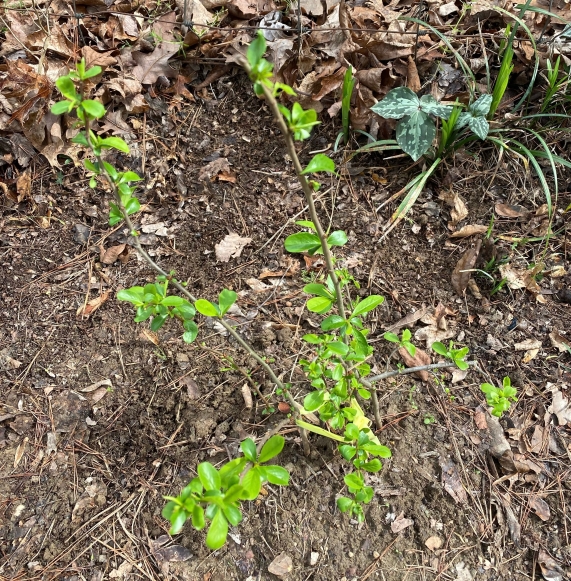
6. The final entry for this week celebrates the emerging of tulips planted in a new bed that memorializes a curly leaf white pine that I had to removed a year ago due to disease. St. Francis sits on a block from the tree’s trunk that is placed on the stump.

The tulip bulbs came in a “variety” bag from Tractor Supply. Whatever colors and shapes the blooms turn out to be will be a springtime surprise. Circling the drip line of the former pine are eight red Double Knock Out Roses I purchased on sale from Home Depot during the winter. So, far at least seven of the eight look healthy. All in all, this is a big box “let’s just see what happens” bed.
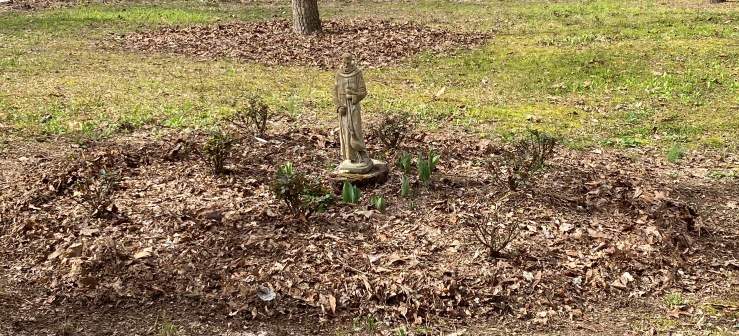
During this time of global health and climate concern, I’ll close by wishing fellow gardeners and everyone else well.










The most reassuring post in my directory in a long time, Susan. No matter what, spring springs. Wishing you good health and hoping your days are filled with many delightful mystery blooms.
LikeLiked by 1 person
Thank you, Gail. Do these days take you back to graduate school readings, and plague poems and iconography? I had been in Iceland. There is an After Eden essay coming on the resultant epiphanies.
LikeLike
Yes, of course. Never more so when the first confirmed case of coronavirus in DC was the rector of a church who had given communion to more than 500 people that week. I kept thinking of how the English clergy was almost wiped out during the plague, kept thinking of that jeweled poem of consolation “Pearl,” a poem that I will re-read.
LikeLiked by 1 person
“A pocket full of posies” for us all!
LikeLike
Susan, I am happy you are home to enjoy all the abundant spring surprises!
LikeLiked by 1 person
Those bluets are dear little things aren’t they? I’m not familiar with them and when I googled loads of US sites came up which makes me think they’re not a big thing in the UK. If not, they should be!
LikeLiked by 1 person
Thanks so much for featuring the Red Buckeye! A small red buckeye that was growing perpendicular to the wall of a deep abyss once saved me from falling. I was hiking with Alabama Wildflower Society members a native plant area above the Tennessee River in Muscle Shoals. I was so busy photographing the beautiful spring ephemerals that I missed my step and slid down the wall. The little bush provided anchor enough for my foot that the folks above were able to pull me to safety. But I, too was able to grow new plants from the fruit of a bush transplanted to the courtyard from the river bank on our property. The little shoots were planted last fall and have survived the winter. Can’t wait for them to get bigger. I was recently at a relative’s house in SC where I planted two of them. They are poisonous to livestock but our horses are gone now and as much as I miss the horses, the buckeyes provide some comfort.
LikeLiked by 1 person
There is a small plant coming up by this one. I might try to transplant it to a better place in the fall.
LikeLike
Rosie looks like she’s up for anything, but I’d have to tell her that the let’s see what happens bed is the best.
LikeLiked by 1 person
Don’t fret. Rosie keeps an eye on all the beds!
LikeLike
I thought buckeye looked familiar. Those who know them seem to be rather fond of them. Ours is not so popular because it defoliates twice annually, once for winter, an again for summer. I happen to like it because it is the only buckeye I know. It is fragrant too.
Anyway, your forsythia might benefit from major pruning. If you prune out all the old deteriorating canes to the ground, resources will be concentrated into younger and more vigorous canes. It is one of those odd plants that gets pruned after bloom an foliation, so it can be pruned later.
LikeLiked by 1 person
Thank you for the pruning advice. Forsythia will not take a very severe pruning will it?
LikeLiked by 1 person
Forsythia can be cut to the ground over winter for renovation. However, I would not recommend doing so. They bloom on canes that grew during the previous year, like so many fruit trees. If cut to the ground over winter, they will not bloom in spring. I prefer to prune out old canes over winter because it is easier for them, and the old canes do not bloom much anyway. It is probably best to instead prune them later in spring, just to get every bit of bloom out of the old canes, even though it is minimal. By that time, the new foliage will not be so fragile.
LikeLike
Love all those photos…but..
That little sweet doggie stole the show.
LikeLiked by 1 person